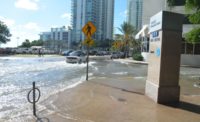U.S. infrastructure is aging. Roads wear down. Power grids face greater demands. A growing percentage of bridges are more than 50 years old. In addition, researchers project that climate change is causing more extreme and more frequent severe weather events, further threatening critical infrastructure.
Meanwhile, the American Society of Civil Engineers estimates a $2.59-trillion (and growing) investment gap between what’s needed for infrastructure in the next 10 years and what will actually be spent.
But with a monumental amount of infrastructure in need of repair, replacement or otherwise improved resilience, how can anyone figure out what to do first?
A new book published by ASCE hopes to help answer that question.
“Impacts of Future Weather and Climate Extremes on United States Infrastructure: Assessing and Prioritizing Adaptation Actions” was prepared by the Task Committee on Future Weather and Climate Extremes. It proposes steps and questions to help prioritize projects to improve infrastructure resilience, looks at threats that extreme weather events pose to infrastructure and assesses the state of various sectors.
The 180-page book highlights the interdependence between different infrastructure sectors and examines how the fragility of one piece of infrastructure can have cascading impacts.
There is a growing list of examples of these problems. Mari Tye, book lead author and a project scientist at the National Center for Atmospheric Research who has also worked as a civil engineer, pointed to the February 2021 Texas winter storms that, as ENR previously reported, froze natural gas gauges at wellheads, causing a shortage at power plants.
That left millions of homes and businesses without power for weeks. Texas officials have linked more than 200 deaths to the winter storms via hypothermia, car crashes, carbon monoxide poisoning, falls, fire and other causes.
The effects were even felt beyond Texas, as freeze-offs at natural gas wells caused the largest monthly drop in U.S. natural gas production on record.
“It just had a knock-on effect on everything else,” Tye says of the Texas storm. “Probably the biggest point we make is, everything is so interdependent that you can’t pick one [infrastructure component] or the other, because it’s either dependent on something else or it will have so many cascading impacts if it goes down.”
To look at the state of different infrastructure sectors, the committee broke them down into five broad categories, rather than the 18 ASCE uses for its annual infrastructure report cards: energy transmission, storage and distribution; transportation; drinking water and wastewater; water storage and flood protection; and navigation, ports and harbors.
“We decided that, if we add climate change to those grades, everything would be an F, and that doesn’t help anybody.,” says Jason Giovannettone, book co-author and a senior engineer and meteorologist at consulting firm Dewberry.
Rather than looking just at the current state of those sectors, the committee discussed factors such as potential impacts of climate change, current resilience and vulnerabilities, readiness to adapt and their interdependencies with other infrastructure sectors.
“Even if one sector is fairly healthy with regard to climate change — which none of them are, but just to say hypothetically — but then that sector depends on another sector that isn’t prepared for climate change, it makes that healthy sector vulnerable,” Giovannettone says.
Priority Projects
The book also looks at ways to prioritize climate-adaptation projects in light of those infrastructure interdependencies and the adaptive capacity different solutions may offer. Prioritization of projects will be unique in different areas depending on their specific exposure to climate change.
But there is a common step-by-step approach that “Impacts” sets out, asking questions about the greatest sensitivities and potential risk reductions to climate change indicators.
What are the interdependencies between local infrastructure sectors, and where could there be cascading impacts? What are the benefits and costs in financial, social and environmental terms? There are many factors in play.
To help ensure all those factors are considered, the book encourages professionals working on infrastructure projects to get out of their silos. Tye pointed to a theoretical example of an aging levee.
She says that just as bringing in a contractor at the design phase of a project can save time and money down the road, involving policymakers, land planners, climate scientists and the people who will be directly affected by the project can have big benefits.
“They may have a different flavor of risk that they are willing to accept,” she says. “It might turn out this enormous flood levee you want to build isn’t what they want in the first place.”
Tye also emphasizes that climate science and climate change effects on infrastructure should be taught at the undergraduate level in a way that promotes multidisciplinary thinking. Undergrads studying engineering now will be tasked with solving many of these infrastructure problems, she says.
“We need to give them the tools and the resources to understand and to be able to facilitate those collaborative conversations and minimize that silo concept, so they go in there with an open mind and a better understanding of all the other players who are working with them,” she says.





Post a comment to this article
Report Abusive Comment